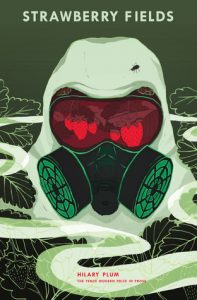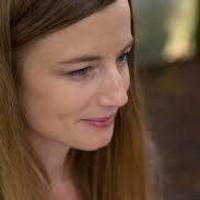by KYLAN RICE
Hilary Plum, Strawberry Fields (Fence 2018), pp. 224
In 2018, Time Magazine named journalists its “Person of the Year.” The magazine published four different versions of the issue’s cover featuring images of either Saudi Arabian journalist Jamal Khashoggi (assassinated on 2 October 2018 by agents of the Saudi government), Filipina journalist Maria Ressa (who reports on President Rodrigo Duterte’s drug war and extrajudicial killings), the staff of the Annapolis newspaper Capital (some of whom were murdered in a recent mass shooting), or the wives of two imprisoned Reuters reporters from Myanmar, Wa Lone and Kyaw Soe Oo. Each individual is a representative casualty or survivor of what the issue calls the “War on Truth” in a cover-story surveying a “post-truth” media landscape marked by divisive partisan news, corporate consolidation, and deliberate misinformation spread by politicians and power brokers—to say nothing of outright violence. Indeed, Time reports that since 2017, 262 journalists have been jailed worldwide. In that same span, four European journalists were murdered in connection with their work, and, with the shooting at the Capital Gazette offices on June 28, 2018, the United States became the fourth-deadliest nation for reporters—a ranking it shares with Mexico, a country “notorious for the dangers its journalists face.”
Time’s cover story is self-reflexive: it meditates on the fact that “[t]he story of this assault on truth is, somewhat paradoxically, one of the hardest to tell,” citing Can Dündar for support. “We all learned in our schools that journalists shouldn’t be the story ourselves,” the exiled Turkish journalist observes, noting that this status quo is no longer possible—or even desirable—to maintain. That news media has become an object of (self-)scrutiny, is, perhaps, a logical extension of the postmodern moment: in 2018, the story became the story.
It is fitting, then, that Hilary Plum’s Strawberry Fields was published in the same year. A series of loosely (dis)connected vignettes told in large part from the perspective of journalists, Plum’s novel ends with a scene in which a foreign correspondent named Alice visits a local reporter, Gabriela, who wastes away in an obscure prison, jailed for dissent. There is something oracular about Gabriela, a withered, putrefying figure, a source of dead, deathly knowledge who speaks from a cage, stating frankly her desire to die in solidarity with the dead women whose stories she told before imprisonment. As a character, she recalls the desiccated Cumaean Sibyl from the epigraph to T.S. Eliot’s “The Waste Land,” which, translated from Latin and Greek reads: “For I indeed once saw with my own eyes the Sibyl at Cumae hanging in her jar, and when the boys asked her, ‘Sibyl, what do you want?’ she answered ‘I want to die.’”
“With my own eyes” is the key phrase from Eliot’s epigraph, for Plum’s novel is a book about witness. Like the Time article, it is, more specifically, a book that witnesses witnesses, that gazes at the sibylline journalist in her cage, herself a figure of ultimate sightedness. And the sibyl’s sight is never-ending. Just so, a reporter named Daniel observes early in Strawberry Fields: “By then in that city even the journalists were dying at unprecedented rates, which seemed to multiply the stories that circulated among us, and often you felt that your work could never end.” Proceeding by this logic, the novel’s stories multiplying in the shadow of global violence at a speed and scale that defies the traditional structure of a coherent narrative, Plum performs the epistemological and narratological crisis involved in telling the story of the story, witnessing witnesses, a self-consuming mise en abyme from which its characters (and, by extension, its readers) must struggle to extricate themselves.
In a recent essay for Brooklyn Rail, Plum explains that the logic of her novel is derived from the experience of reading a newspaper: “The novel moves quickly among settings and situations in an exaggerated echo of the daily newspaper and its disorientation, where the story of a new US drone base in Niger yields to the write-up of a wedding in New York, which yields to a follow-up on the long water crisis in Flint.” As a result, Strawberry Fields is a meditation on reading practices in a hypernetworked age, as well as a referendum on the kinds of meaning we extract or even fabricate for ourselves in the midst of a random proliferation of events entangled by inscrutable but indubitable webs of association. As characters work together to try to solve the murder of five private military mercenaries and Iraq war veterans (the novel’s one recurring narrative), a private detective named Modigliani points out to the journalist Alice, “your thinking is the opposite of conspiratorial. It’s the web without the spider.” Like Alice, readers of Plum’s novel discover (much like the readers of a newspaper), webs without spiders, attempts to make sense of senseless violence. In this way, Strawberry Fields resonates with the vicious cycles of Roberto Bolaño’s 2666 and Patrick Modiano’s murky, Nobel prize-winning detective-style fiction. In 2666, Bolaño spends the fourth and largest part of his novel, “The Part about the Crimes,” enumerating a seemingly endless series of brutal murders, the victims all women. The murders appear to be connected but fail to crystalize into a coherent pattern pointing to a single perpetrator. In the end, it becomes apparent that this violence is systemic, essentially impersonal, a widespread cancer with no central tumor. Similarly, Modiano’s noir-ish novels and novellas offer indistinct clues regarding vague, unexplained disappearances through a fog of memory that never fully coalesces into a narrative solution. Plum shares with Bolaño and Modiano the disarming, often terrifying ability to stimulate the readerly realization that there is no conspiracy. Instead, in the absence of narrative teleology, there are only reading practices, an askesis of ongoing attention.
And yet, the practice of attention is not held out in Strawberry Fields as a solution to the problems of meaningless violence. The final lines of the novel, narrated from Gabriela’s jailed perspective, leave both reader and journalist bereft of the moral security that an ethics of witness might otherwise provide:
“We’ll remember you, she said.
I told her the truth. I said: That’s no consolation
Her tears didn’t even make it to the floor.”
What would be a consolation for Gabriela? Freedom? Justice? Revenge? In any case, remembrance and visibility are not enough, especially given the miniscule attention span of the news media cycle, which Alice represents. This is perhaps the most significant and also the most frustrating realization of the novel: Plum disables an ethics of witness, even having mobilized it, and does not provide a clear alternative. Yet the book’s self-dissolution seems to be the point. As Gabriela points out, “There is a screen…and if you write it right anyone reading will think, ah, a screen, and know the truth is behind it.” This is the aim of Time’s person-of-the-year coverage, too: turn the screen, the media, into an opaque, reflective surface that initially makes itself scrutable in order to deflect attention away from itself and reveal, once again, the injustices that permeate global society. In the final moment of the novel, Plum ensures that the work of paying attention does not become merely recursive or tautological, imprisoned in a hanging jar.
The novel’s thematization of witness is best illustrated in a chapter called “Grigory.” Plum often obfuscates the real-world settings of her vignettes, but leaves hints and suggestions that might stake the fiction somewhere in an identifiable reality. “Grigory,” for instance, might take place close to the West Bank wall. The titular character is one of the few non-journalistic figures in the novel, but the vignette still centers on a web-video filmed by a reporter. Embedded in a viral email sent to Grigory, the video shows a man’s young son getting killed in crossfire:
“Someone in some sort of window has chosen to film this man and this boy, and with a fairly steady hand, as though aware that of all the events in the territories these weeks, this one, this street would be the single event of significance, or at least this is what this person, this foreign woman journalist (as she says she is), wants to ensure…We see only the car and the man and the boy, we have no way of knowing how near the gunfire is—the other end of the block, or a street over, or it could all have been simulated, either digitally or at the scene…The camera’s focus is so precise—the car, the man, the boy—nothing could be identified from the scene, no exact location.”
The scene is Plum’s novel in miniature. Much like the “foreign woman journalist,” Plum’s hand is steady as she frames and fictionalizes events that correlate to the real world. Her focus is precise: readers are given only hints of what lies beyond the highly lyrical and thus artificial Claude-glass narratives of Strawberry Fields—the real deprivations of Hurricane Katrina, the capture of Saddam Hussein, the bloody troubles in Northern Ireland, the lurid brutalities of Guantanamo and Abu Ghraib. The precision of the details we do get in Strawberry Fields seems hyperreal, aestheticized, almost distracting: a droplet of tea falls on a thumbnail, “a heron lift[s] off from a pond in the green” at the same speed as a slow-moving car, the combined scent of sweat and bombshells smells like “sweetgrass left out to hay.” In the “Grigory” chapter, Plum implicates herself and her readers in the pornographic cycles of production and consumption that swirl in ever-widening gyres around acts of uncoordinated geopolitical violence. What ultimately redeems Strawberry Fields from self-indictment is that it trains its focus not on violence but on the practices of consuming violence, often facilitated by journalism and news media. Plum’s novel has to be artificial and hyperrealistic because it is obligated to call attention to itself as a “screen” in order to subsequently call attention to what lies behind, or even what hovers above its pages, gazing down. Perhaps, then, it isn’t wholly accurate to compare Strawberry Fields to Time’s recent person-of-the-year article. For Plum does not tell a story about the story as much as she relays a story about the reader of the story, where the reader is a kind of journalist, an Alice for whom the story never culminates, clarifies, or resolves.
Strawberry Fields begins with an epigraph by the poet Zach Savich, Plum’s husband: “Yet through the country of / My eyes had no color but what they saw.” Savich’s lines convey an essentially poetic sentiment. After all, it was John Keats who said that “A Poet is the most unpoetical of any thing in existence; because he has no Identity – he is continually in for – and filling some other Body – The Sun, the Moon, the Sea and Men and Women who are creatures of impulse are poetical and have about them an unchangeable attribute – the poet has none; no identity – he is certainly the most unpoetical of all God’s Creatures.” Plum’s novel takes this sentiment not as truth, but as an idea about art and art-making deserving critique. “How pretty your poems are,” one character says to another, the fictional Yeats-like poet Malachy: “You must…have all your coats laundered regularly, to be sure the blood of our martyrs hasn’t spattered upon you, you do like to stand so close and watch.” Strawberry Fields focuses its unwavering gaze not on the martyr, but on the blood on the hems of the poet, the novelist, and the reader, who, in moving through the countries of the world, skimming the columns of the newspaper, discover precisely the color of their own embodied eyes. And with them look up from the page.



